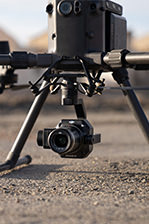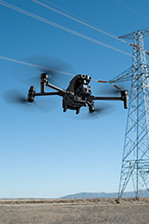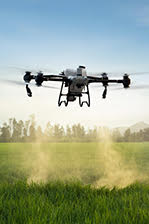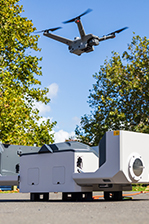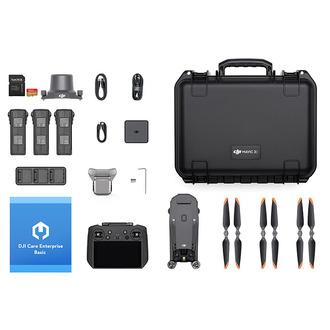DJI Dock 2 (DJI Matrice 3D)
Dock 2 is lightweight, offers high-level operation capabilities, and has cloud-based intelligent functions that bring efficiency and quality to unattended operations.
Easy Operation, Superior Results
The more capable yet noticeably smaller DJI Dock 2 deploys Matrice 3D or 3TD drones with ease and security. Dock 2 is lightweight, offers high-level operation capabilities, and has cloud-based intelligent functions that bring efficiency and quality to unattended operations.
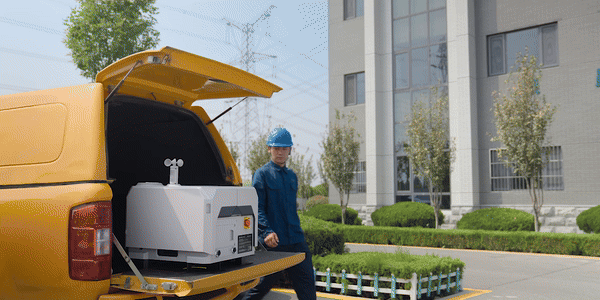
Easy Deployment, Ready to Go
Lightweight Design
DJI Dock 2 is 75% smaller and 68% lighter than its predecessor and is easily transportable with just two individuals, which makes for flexible installation and reduces installation costs.
Efficient Site Evaluation
Before deployment, the aircraft can detect the surrounding environment using vision sensors and quickly determine whether the area has strong GNSS signals. [4] This new vision-based evaluation markedly accelerates site selection, reducing the required time from five hours to twelve minutes or less. [5]
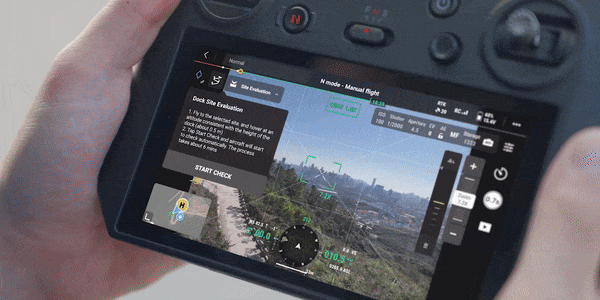
Rugged, Reliable, Recharged
IP55 Dustproof and Waterproof
DJI Dock 2 is designed with safeguarding in mind. With an IP55 dust and water resistance rating, [1] Dock 2 can operate steadily for extended periods even in harsh climates and environments.
Integrated Environmental Monitoring System
DJI Dock 2 integrates multiple sensors, including rainfall, wind speed, and temperature gauges, to perceive real-time weather changes. In conjunction with online weather forecasting, it can provide timely warnings or terminate flight tasks using DJI FlightHub 2 to effectively reduce flight risk.
Improved Landing Stability
With next-gen image recognition technology, the aircraft accurately identifies positioning markers on the landing pad. Additionally, the landing pad's new slide-ramp centering design further facilitates precise landing.
Built-In Backup Battery
In the case of an unexpected power outage, DJI Dock 2 can continue to operate independently for over five hours [6] with the built-in backup battery, leaving sufficient time for the aircraft to return and land.
Six-Month Maintenance Interval
With its high level of protection and reliability, DJI Dock 2 only requires maintenance approximately every six months, [7] effectively controlling human resource costs.
Abnormal Condition Notifications
If DJI Dock 2 and the aircraft encounter task failures or emergencies, DJI FlightHub 2 will immediately send email notifications. This allows operators to accurately trace and troubleshoot problems based on the provided information.
High-Performance Aircraft Models
The all-new DJI Matrice 3D/3TD is specifically designed for DJI Dock 2. Matrice 3D is equipped with both a tele camera and a wide-angle camera with a mechanical shutter, meeting the needs for 1:500 high-precision mapping tasks. Matrice 3TD, outfitted with a wide-angle camera, a tele camera, and an infrared camera, can depict both visible light and thermal images, making it suitable for security and inspection operations.
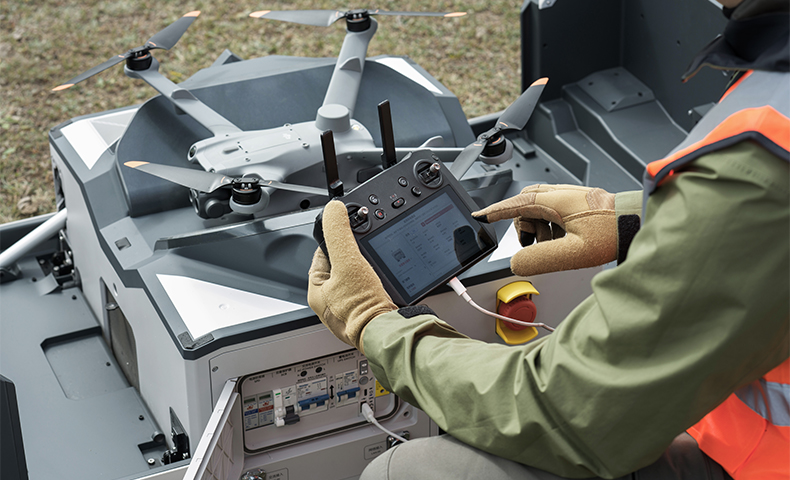
DJI Matrice 3D
Wide-Angle Camera
4/3 CMOS
24mm Format Equivalent
20MP Effective Pixels
Mechanical Shutter
Tele Camera
1/2-inch CMOS
162mm Format Equivalent
12MP Effective Pixels
DJI Matrice 3TD
Wide-Angle Camera
1/1.32-inch CMOS
24mm Format Equivalent
48MP Effective Pixels
Tele Camera
1/2-inch CMOS
162mm Format Equivalent
12MP Effective Pixels
Infrared Camera
40mm Format Equivalent
Normal Mode: 640×512@30fps
UHR Infrared Image Mode: 1280×1024@30fps (With the UHR Infrared Image function enabled, the aircraft automatically enables or disables UHR Infrared Image mode according to the ambient light brightness.)
28x Digital Zoom
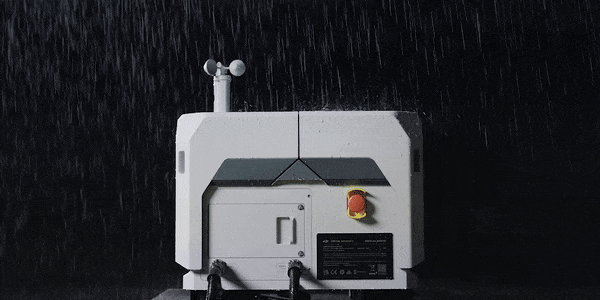
Superior, Comprehensive Performance
Thanks to its powerful operation capabilities, DJI Matrice 3D/3TD meets the requirements of high-standard operations.
IP54 - Dustproof and Waterproof [1]
50 Mins - Max Flight Time [8]
6-Directional - Obstacle Sensing System [9]
10 km - Max Effective Operating Radius [2]
400 - Battery Cycles [10]
Integrated RTK Module - ±3cm Positioning Accuracy
Steady Operation, Uncompromised Efficiency
Quick Takeoff
DJI Dock 2 integrates dual RTK antennas, allowing the aircraft to obtain accurate RTH location information without waiting for the RTK data to converge. It also performs a complete propeller inspection and takeoff in as short a time as 45 seconds, [11] quickly entering operational status.
Quick Charging
DJI Dock 2 charges the aircraft from 20% to 90% in just 32 minutes [12] for efficient powering for consecutive operations.
Dual-Camera Monitoring
DJI Dock 2 features an internal and an external fisheye camera to achieve real-time display. Close monitoring within and outside the dock allows the operator to remotely observe weather conditions, environmental circumstances, and the aircraft's takeoff and landing.
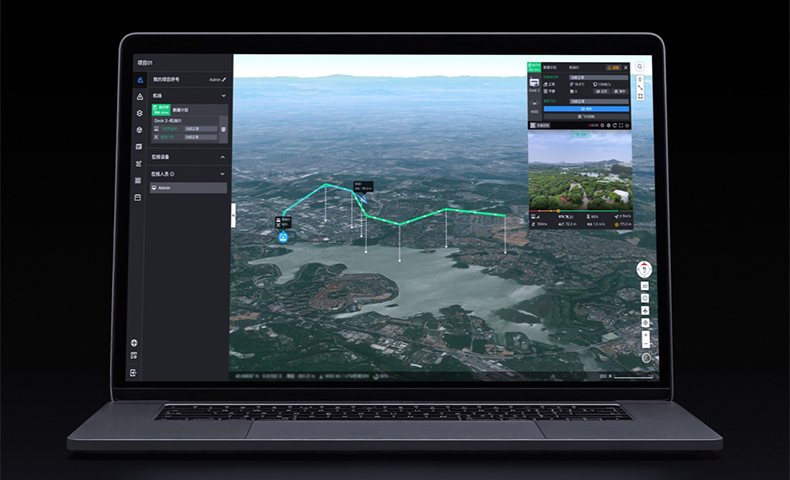
Cloud-Based Operation, Maximum Control
Cloud Mapping
After the aircraft completes its flight task, DJI FlightHub 2 generates high-precision 3D models based on the collected flight data, authentically restoring the operating environment. These models can be annotated, measured, and downloaded.
Flight Route Editor
Utilising high-precision 3D models, operators can conduct visual flight route editing from a first-person perspective and preview simulated imaging results. This facilitates intuitive and efficient operations and enhances flight route planning and accuracy.
AI Spot-Check
Frame a specific area in the 3D model, and the aircraft will automatically compare the area to be captured with the framed area in subsequent automated operations. This actively adjusts the camera's angle to ensure accurate capture of the same area across multiple flights.
FlyTo Tasks
DJI FlightHub 2's FlyTo tasks utilise high-precision 3D models to automatically plan the optimal flight route. Before an urgent task, the operator only needs to click on the subject, and the aircraft will fly to the destination via an efficient and safe route.
Live Flight Controls
Based on DJI FlightHub 2 or a third-party cloud platform, even if DJI Dock 2 is deployed in a remote region, the operator can still control the flight and gimbal angle via keyboard and mouse.
Obstacle Bypass
When performing automatic flight tasks, the aircraft utilizes omnidirectional obstacle sensing and automatic obstacle bypass functions to enhance the success rate of flight tasks.
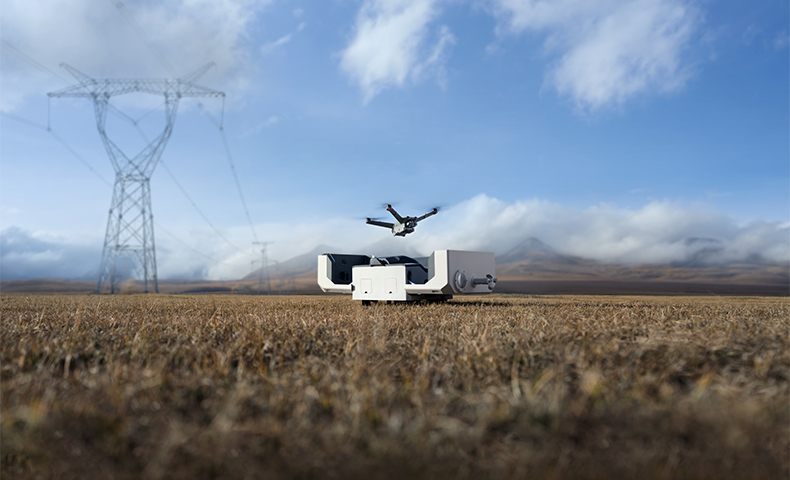
Open Ecosystem, Extensive Capabilities
Third-Party Payloads
Add even more functionality, connect to third-party payloads [3] such as loudspeakers and spotlights via the aircraft's E-Port, and remotely control added payload via DJI FlightHub 2. [13] Additionally, the aircraft's E-Port Lite supports connection to a parachute [3] for increased flight and personnel safety.
Edge Computing
DJI Dock 2 has an edge computing expansion interface that enables the pre-processing of media files and more to improve operational efficiency further.
Private Deployment With Cloud API
Tailor a customised management system for DJI Dock 2 with Cloud API or quickly connect it to a third-party cloud platform, facilitating efficient and convenient private deployment.
Cloud-to-Cloud Coordination
Through DJI FlightHub 2's FlightHub Sync function, users can easily link it to a third-party cloud platform for flexible management of operation data.
DJI TerraAPI
With the DJI TerraAPI, users can now integrate the powerful mapping capabilities of DJI Terra into their own dock management systems. This enables automated 2D/3D reconstruction and customised photo mapping workflows, allowing the operation results of DJI Dock 2 to better meet the needs of a wide variety of industry applications.
Notes
* Always check and strictly abide by local laws and regulations before flying.
** All data on this page was collected using a production model DJI Dock 2 and DJI Matrice 3D/3TD in a controlled environment. Actual results may vary depending on the environment, usage, and firmware version.
*** All videos and images on this page were shot in strict compliance with relevant local laws and regulations.
**** DJI Matrice 3D/3TD must be activated via the DJI Pilot 2 app before use.
***** To ensure that the equipment operates steadily and continuously, please perform regular maintenance. For details, refer to the Maintenance Manual.
DJI Dock 2 is IP55 rated, and DJI Matrice 3D/3TD is IP54 rated. Both are tested under controlled laboratory conditions. The IP rating is not permanently effective and may decrease due to product wear and tear. For details, refer to the User Manual.
Measured in an environment of approximately 25°C (77°F) with a reserve battery level of 25%, ambient wind speed of approximately 4 m/s, round-trip flight speed of approximately 15 m/s, and hovering operation of 10 minutes. This value is for reference only, and the actual operation data may vary.
3. Sold separately.
DJI Matrice 3D/3TD or the DJI Mavic 3 Enterprise Series aircraft can be used.
When the aircraft has sufficient battery level, the following operations can be completed in 12 minutes: Turn on the DJI Matrice 3D Series drone and connect it to the DJI RC Pro Enterprise. Enter DJI Pilot 2, select the Dock Site Evaluation function, and then finish the site evaluation step by step according to the instructions until the evaluation results are obtained. This value is for reference only, and the actual experience may vary.
Measured with a fully charged backup battery in a 25°C (77°F) environment. After a power outage, the dock does not support functions like aircraft charging, air conditioning, dock cover heating, and wind speed gauge heating. Always check malfunctions promptly.
Measured in a windless, sand-free, and non-erosive environment at 25°C (77°F). Actual maintenance intervals should be determined based on the deployment environment and operating frequency. It is recommended to conduct maintenance every six months or sooner.
Measured in a controlled test environment. Specific test conditions are as follows: flying forward at a constant speed of 46.8 kph in a windless laboratory environment at 20 metres above sea level, in photo mode (without photo-taking operation during flight), with Obstacle Avoidance Action set to Off, and from 100% battery level until 0%. Results may vary depending on the environment, actual use, and firmware version.
The aircraft has a 10° blind spot in the upper rear area. Always fly with caution.
Within 12 months, when the ambient temperature for battery storage is below 35°C (95°F), and the cumulative time with a battery level of 90% or higher is less than 120 days, the battery cycles can reach 400 times.
In an environment with good network signals, it takes approximately 45 seconds, the fastest from when the operator clicks Take Off in DJI FlightHub 2 to when the aircraft leaves the landing pad. This value is for reference only, and the actual experience may vary.
Measured in a 25°C (77°F) environment while charging.
Please consult your dealer first to ensure that the payload is compatible with DJI FlightHub 2.
Product Specifications
Dock - General
Product Name: DJI Dock 2
Total Weight: 34 kg (without aircraft)
The actual product weight may vary due to differences in batch materials and external factors.
Dimensions: Dock Cover Opened: 1228×583×412 mm (L×W×H)
Dock Cover Closed: 570×583×465 mm (L×W×H)
The above data does not include the height of the wind speed gauge (145 mm) but includes the height of the mounting base brackets (55 mm).
Input Voltage: 100-240 V (AC), 50/60 Hz
Input Power: Max 1000 W
Operating Temperature: -25° to 45° C (-13° to 113° F)
When the ambient temperature is below -20° C (-4° F), the dock is in standby status, and the aircraft cannot perform flight tasks.
Ingress Protection Rating: IP55
Number of Drones Accommodated: 1
Max Allowable Landing Wind Speed: 8 m/s
Max Operating Altitude: 4000 m
Receiving Frequency of RTK Base Station Satellite: Simultaneously receive:
GPS: L1 C/A, L2
BeiDou2: B1l, B2l, B3l
BeiDou3: B1l, B3l
GLONASS: L1, L2
Galileo: E1, E5B
Positioning Accuracy of RTK Base Station: Horizontal: 1 cm + 1 ppm (RMS)
Vertical: 2 cm + 1 ppm (RMS)
Dock - Charging Performance
Output Voltage: 28 V DC
Charging Time: 32 minutes
The data was measured when charging the aircraft (when powered off) from 20% to 90% in a 25° C (77° F) environment.
Dock - Video Transmission
Video Transmission System: O3 Enterprise
Operating Frequency: 2.4000-2.4835 GHz
5.725-5.850 GHz
Antenna: Built-in 4 antennas, 2T4R, supports intelligent switching
Transmitter Power (EIRP): 2.4 GHz: < 33 dBm (FCC); < 20 dBm (CE/SRRC/MIC)
5.8 GHz: < 33 dBm (FCC); < 14 dBm (CE); < 23 dBm (SRRC)
Dock - Air Conditioning System
Operating Voltage: 28 V DC
Air Conditioning Type: TEC Air Conditioning
Dock - Backup Battery
Battery Capacity: 12 Ah
Output Voltage: 12 V
Battery Type: Lead-acid battery
Battery Life: > 5 hours
Measured with a fully charged backup battery in a 25° C (77° F) environment. After a power outage, the dock does not support functions like aircraft charging, air conditioning, dock cover heating, and wind speed gauge heating. Always check malfunctions promptly.
Dock- Network Access
Ethernet Access: 10/100/1000Mbps adaptive Ethernet port
Dock - Sensor
Wind Speed Sensor: Supported
Rainfall Sensor: Supported
Ambient Temperature Sensor: Supported
Water Immersion Sensor: Supported
In-Cabin Temperature Sensor: Supported
In-Cabin Humidity Sensor: Supported
Dock - Security Camera (External)
Resolution: 1920×1080
Field of View (FOV): 151°
Auxiliary Light: Auxiliary White Light
Resolution: 1920×1080
Field of View (FOV): 151°
Auxiliary Light: Auxiliary White Light
Dock- Lightning Protection
AC Power Port: 20 kA (rated value), meets EN 61643-11 Type 2 and IEC 61643-1 Class Ⅱ protection level requirements
Ethernet Port: 10 kA (Itotal),meets EN/IEC 61643-21 Category C protection level requirements
Dock - Supported Software
Applications: DJI Pilot 2 (connects to DJI Dock 2 via DJI RC Pro Enterprise for deployment and commissioning)
Cloud Platform: DJI FlightHub 2 (supported by default)
Third-party cloud platforms (accessed through DJI Cloud API)
Dock - Expansion Capability
Open Protocol: DJI Cloud API
Edge Computing: Supports data communication with external switches
Aircraft - General
Weight: 1410 g
This value includes the weight of the battery, propellers, and a microSD card, but does not include third-party payloads. The actual product weight may vary due to differences in batch materials and external factors.
Max Takeoff Weight: 1610 g
Dimensions: 335×398×153 mm (L×W×H, without propellers)
Wheelbase: Diagonal Wheelbase: 463.2 mm
Left-Right Wheelbase: 359.9 mm
Front-Rear Wheelbase: 291.4 mm
Max Ascent Speed: 6 m/s (Normal Mode)
8 m/s (Sport Mode)
Max Descent Speed: 6 m/s (Normal Mode)
6 m/s (Sport Mode)
Max Horizontal Speed (at sea level, no wind): Normal Mode, With Obstacle Sensing Enabled: 15 m/s flying forward, 12 m/s flying backward, 10 m/s flying sideways
Sport Mode: 21 m/s flying forward, 18 m/s flying backward, 16 m/s flying sideways
Max Wind Speed Resistance: During Operation: 12 m/s
During Takeoff/Landing: 8 m/s
Max Takeoff Altitude: 4000 m
Max Flight Time: 50 minutes
Measured in a controlled test environment. Specific test conditions are as follows: flying forward at a constant speed of 46.8 kph in a windless laboratory environment at 20 meters above sea level, in photo mode (without photo-taking operation during flight), with Obstacle Avoidance Action set to Off, and from 100% battery level until 0%. Results may vary depending on the environment, actual use, and firmware version.
Max Hovering Time: 40 minutes
Measured with the DJI Matrice 3D series drones hovering in a windless environment at 20 meters above sea level and from 100% battery level until 0%. Results may vary depending on the environment, actual use, and firmware version.
Max Operating Radius: 10 km
Measured in an environment of approximately 25° C (77° F) with a safe battery level of 25%, ambient wind speed of approximately 4 m/s, round-trip flight speed of approximately 15 m/s, and hovering operation of 10 minutes. Results may vary depending on the environment, actual use, and firmware version.
Max Flight Distance: 43 km
Measured with DJI Matrice 3D/3TD flying at a constant speed of 54 kph in a windless environment at 20 meters above sea level and from 100% battery level until 0%. Results may vary depending on the environment, actual use, and firmware version.
Max Pitch Angle: 25° (Normal Mode)
25° (Sport Mode)
Max Angular Velocity: 250°/s
Global Navigation Satellite System: GPS + Galileo + BeiDou + GLONASS (GLONASS is supported only when the RTK module is enabled.)
Hovering Accuracy Range (windless or breezy): Vertical:
±0.1 m (with vision positioning)
±0.5 m (with GNSS positioning)
±0.1 m (with RTK positioning)
Horizontal:
±0.3 m (with vision positioning)
±0.5 m (with GNSS positioning)
±0.1 m (with RTK positioning)
Operating Temperature: -20° to 45° C (-4° to 113° F)
Ingress Protection Rating: IP54
Motor Model: 2607
Propeller Model: 1149, foldable, non-quick release
RTK Module: Integrated on the aircraft
Beacon: Integrated on the aircraft
Aircraft - Wide-Angle Camera
Image Sensor: DJI Matrice 3D: 4/3 CMOS, Effective Pixels: 20 MP
DJI Matrice 3TD: 1/1.32-inch CMOS, Effective Pixels: 48 MP
Lens: DJI Matrice 3D
FOV: 84°
Format Equivalent: 24 mm
Aperture: f/2.8-f/11
Focus: 1 m to ∞
DJI Matrice 3TD
FOV: 82°
Format Equivalent: 24 mm
Aperture: f/1.7
Focus: 1 m to ∞
Lens Defogging: DJI Matrice 3D: The wide-angle camera supports lens defogging.
DJI Matrice 3TD: The wide-angle camera supports lens defogging.
ISO Range: DJI Matrice 3D: 100-6400
DJI Matrice 3TD: 100-25600
Shutter Speed: DJI Matrice 3D
Electronic Shutter: 8-1/8000 s
Mechanical Shutter: 8-1/2000 s
DJI Matrice 3TD
Electronic Shutter: 8-1/8000 s
Max Image Size: DJI Matrice 3D: 5280×3956
DJI Matrice 3TD: 8064×6048
Still Photography Modes: DJI Matrice 3D
Single: 20 MP
Timed: 20 MP, 0.7/1/2/3/5/7/10/15/20/30/60 s
Smart Low-light: 20 MP
Panorama: 20 MP (raw image); 100 MP (stitched image)
DJI Matrice 3TD
Single: 12 MP, 48 MP
Timed: 12 MP, 48 MP, 0.7/1/2/3/5/7/10/15/20/30/60 s*
Smart Low-light: 12 MP
Panorama: 12 MP (raw image); 100 MP (stitched image)
* The 0.7s and 1s intervals are not supported when taking 48MP timed photos.
Video Resolution: H.264
4K: 3840×2160@30fps
FHD: 1920×1080@30fps
Video Bitrate: DJI Matrice 3D
4K: 130 Mbps
FHD: 70 Mbps
DJI Matrice 3TD
4K: 85 Mbps
FHD: 30 Mbps
Supported File System: exFAT
Photo Format: JPEG
Video Format: MP4 (MPEG-4 AVC/H.264)
Aircraft - Tele Camera
Image Sensor: 1/2-inch CMOS, Effective Pixels: 12 MP
Lens: FOV: 15°
Format Equivalent: 162 mm
Aperture: f/4.4
Focus: 3 m to ∞
Lens Defogging: DJI Matrice 3D: The tele camera supports lens defogging.
DJI Matrice 3TD: The tele camera supports lens defogging.
ISO Range: DJI Matrice 3D: 100-6400
DJI Matrice 3TD: 100-25600
Shutter Speed: Electronic Shutter: 8-1/8000 s
Max Image Size: 4000×3000
Photo Format: JPEG
Video Format: MP4 (MPEG-4 AVC/H.264)
Still Photography Modes: DJI Matrice 3D
Single: 12 MP
Timed: 12 MP, 0.7/1/2/3/5/7/10/15/20/30/60 s
Smart Low-light: 12 MP
DJI Matrice 3TD
Single: 12 MP
Timed: 12 MP, 0.7/1/2/3/5/7/10/15/20/30/60 s
Smart Low-light: 12 MP
Video Resolution: H.264
4K: 3840×2160@30fps
FHD: 1920×1080@30fps
Video Bitrate: DJI Matrice 3D
4K: 130 Mbps
FHD: 70 Mbps
DJI Matrice 3TD
4K: 85 Mbps
FHD: 30 Mbps
Digital Zoom: 8x (56x hybrid zoom)
Aircraft - Infrared Camera (DJI Matrice 3TD)
Thermal Imager: Uncooled VOx Microbolometer
Pixel Pitch: 12 μm
Frame Rate: 30 Hz
Lens: FOV: 61°
Format Equivalent: 40 mm
Aperture: f/1.0
Focus: 5 m to ∞
Do not expose the infrared camera lens to strong sources of energy, such as the sun, lava, or a laser beam. Otherwise, the camera sensor may be burned, leading to permanent damage.
Sensitivity: ≤ 50 mk@F1.0
Temperature Measurement Method: Spot Measurement, Area Measurement
Temperature Measurement Range: -20° to 150° C (-4° to 302° F, High Gain Mode)
0° to 500° C (32° to 932° F, Low Gain Mode)
Palette: White Hot/Black Hot/Tint/Iron Red/Hot Iron/Arctic/Medical/Fulgurite/Rainbow 1/Rainbow 2
Photo Format: JPEG (8-bit)
R-JPEG (16-bit)
Video Resolution: Normal Mode: 640×512@30fps
UHR Infrared Image Mode: 1280×1024@30fps (With the UHR Infrared Image function enabled, the aircraft can automatically enable or disable UHR Infrared Image mode according to the ambient light brightness.)
Video Bitrate: 6 Mbps
Video Format: MP4 (MPEG-4 AVC/H.264)
Still Photography Modes: Single
Normal Mode: 640×512
UHR Infrared Image Mode: 1280×1024
Timed
Normal Mode: 640×512, 0.7/1/2/3/5/7/10/15/20/30/60 s
UHR Infrared Image Mode: 1280×1024, 0.7/1/2/3/5/7/10/15/20/30/60 s
Digital Zoom: 28x
Infrared Wavelength: 8-14 μm
Infrared Temperature Measurement Accuracy: ±2° C or ±2% (using the larger value)
Aircraft - Gimbal
Stabilization: 3-axis mechanical gimbal (tilt, roll, pan)
Mechanical Range: Tilt: -135° to +45°
Roll: -45° to +45°
Pan: -27° to +27°
Controllable Range: Tilt: -90° to +35°
Pan: Not controllable
Max Control Speed (tilt): 100°/s
Angular Vibration Range: ±0.005°
Aircraft - Sensing
Sensing Type: The aircraft supports six-directional obstacle sensing.
The aircraft has a 10° blind spot in the upper rear area. Always fly with caution.
Forward: Measurement Range: 0.5-21 m
Detection Range: 0.5-200 m
Effective Sensing Speed: Flight Speed ≤ 15 m/s
FOV: Horizontal 90°, Vertical 90°
Backward: Measurement Range: 0.5-23 m
Effective Sensing Speed: Flight Speed ≤ 12 m/s
FOV: Horizontal 90°, Vertical 90°
Lateral: Measurement Range: 0.5-15 m
Effective Sensing Speed: Flight Speed ≤ 10 m/s
FOV: Horizontal 104°, Vertical 90°
Upward: Measurement Range: 0.5-21 m
Effective Sensing Speed: Flight Speed ≤ 6 m/s
FOV: Front and Back 90°, Left and Right 90°
Downward: Measurement Range: 0.5-14 m
Effective Sensing Speed: Flight Speed ≤ 6 m/s
FOV: Front and Back 95°, Left and Right 110°
Operating Environment: Forward, Backward, Left, Right, and Upward: Surfaces with discernible patterns and adequate lighting (lux > 15)
Downward: Diffuse reflective surface with diffuse reflectivity > 20% (e.g. walls, trees, people) and adequate lighting (lux > 15)
Aircraft - Video Transmission
Video Transmission System: DJI O3 Enterprise Transmission
Live View Quality: 720p/30fps, 1080p/30fps (with DJI RC Pro Enterprise)
540p/30fps, 720p/30fps, 1080p/30fps (with DJI FlightHub 2)
Operating Frequency: 2.4000-2.4835 GHz
5.150-5.250 GHz (CE: 5.170-5.250 GHz)
5.725-5.850 GHz
In some countries and regions, the 5.1GHz and 5.8GHz frequency bands are prohibited, or the 5.1GHz frequency band is only allowed for indoor use. Please refer to local laws and regulations for more information.
Max Transmission Distance (unobstructed, free of interference): DJI Matrice 3D
FCC: 15 km
CE: 8 km
SRRC: 8 km
MIC: 8 km
DJI Matrice 3TD
FCC: 15 km
CE: 8 km
SRRC: 8 km
MIC: 8 km
Measured in an unobstructed outdoor environment free of interference. The above data shows the farthest communication range for one-way, non-return flights under each standard. Always pay attention to RTH reminders in DJI FlightHub 2 during your flight.
Max Transmission Distance (unobstructed, with interference): Strong Interference (dense buildings, residential areas, etc.): 1.5-3 km (FCC/CE/SRRC/MIC)
Medium Interference (suburban areas, city parks, etc.): 3-9 km (FCC), 3-6 km (CE/SRRC/MIC)
Low Interference (open spaces, remote areas, etc.): 9-15 km (FCC), 6-8 km (CE/SRRC/MIC)
Measured with the aircraft flying (without third-party payloads) in unobstructed environments with typical interference. The above data shows the farthest communication range for one-way, non-return flights under each standard. Always pay attention to RTH reminders in DJI FlightHub 2 during your flight.
Max Download Speed: 5 MB/s (with DJI Dock 2)
15 MB/s (with DJI RC Pro Enterprise)
Measured in a laboratory environment with little interference in countries/regions that support both 2.4 GHz and 5.8 GHz. Download speeds may vary depending on the actual conditions.
Lowest Latency: The video transmission latency from the aircraft to the dock is approximately 110 to 150 milliseconds (affected by the actual environmental conditions).
The video transmission latency from the dock to DJI FlightHub 2 is affected by the actual network conditions and the computer's configuration.
Antenna: 4 antennas, 2T4R
Transmitter Power (EIRP): 2.4 GHz: < 33 dBm (FCC), < 20 dBm (CE/SRRC/MIC)
5.1 GHz: < 23 dBm (CE)
5.8 GHz: < 33 dBm (FCC/SRRC), < 14 dBm (CE)
Aircraft - Storage
Supported Memory Cards: Aircraft:
U3/Class10/V30 or above is supported. A list of recommended microSD cards can be found below.
Recommended microSD Cards: Aircraft:
SanDisk Extreme 32GB V30 A1 microSDHC
SanDisk Extreme PRO 32GB V30 A1 microSDHC
SanDisk Extreme 512GB V30 A2 microSDXC
Lexar 1066x 64GB V30 A2 microSDXC
Kingston Canvas Go! Plus 64GB V30 A2 microSDXC
Kingston Canvas React Plus 64GB V90 A1 microSDXC
Kingston Canvas Go! Plus 128GB V30 A2 microSDXC
Kingston Canvas React Plus 128GB V90 A1 microSDXC
Kingston Canvas React Plus 256GB V90 A2 microSDXC
Samsung PRO Plus 256GB V30 A2 microSDXC
Aircraft - Battery
Capacity: 7811 mAh
Voltage: 14.76 V
Max Charging Voltage: 17.0 V
Type: Li-ion 4S
Chemical System: LiNiMnCoO2
Energy: 115.2 Wh
Weight: 544 g
Cycle Count: 400
Charging Temperature: 5° to 45° C (41° to 113° F)
Aircraft - Power Adapter
Input: 100-240 V (AC), 50/60 Hz, 2.5 A
Output Power: 100 W
Output: Max output power of 100 W (total)
When both ports are used, the power adapter will dynamically allocate the output power of the two ports according to the load power, and the maximum output power of one of the ports is 82 W.
Aircraft - Charging Base
Input: USB-C: 5-20 V, 5.0 A
Output: Battery Port: 12-17 V, 8.0 A
Rated Power: 100 W
Charging Type: One battery charged at a time
Charging Temperature: 5° to 40° C (41° to 104° F)
In the box
DJI Dock 2
Dock Body (incl. Earth Wire) × 1
Wind Speed Gauge Module × 1
Expansion Bolt × 4
Ethernet Cable Connector × 1
Power Cable Connector × 1
Wire Ferrule × 6
Screws and Tools × 1
DJI Matrice 3D
Aircraft (with microSD card inserted) × 1
CW Propellers (Pair) × 1
CCW Propellers (Pair) × 1
Screws and Washers × 1
DJI Matrice 3D Series Intelligent Flight Battery × 1
DJI RC Pro Enterprise × 1
WHY BUY FROM US?
By buying from Ferntech, you'll have the confidence that you are dealing directly with New Zealand's leading drone experts. Our staff are knowledgable drone pilots who offer expert advice, trusted support and superior specialist service. Only through us will you receive a full New Zealand warranty, phone and email support, and access to our certified Repairs Centre with DJI-qualified drone technicians. And we guarantee that we will have the best prices on the market — if not let us know and we will match any price (conditions apply).
Warranty Details
Dock
What is the difference between DJI Dock 2 and DJI Dock?
Compared with DJI Dock, DJI Dock 2 has a significantly reduced size and weight and comes with the exclusive DJI Matrice 3D series drone. It boasts a lightweight design and easy deployment while offering superior operation capabilities and cloud-based intelligent functions. Overall, it significantly lowers the threshold of unattended operation, pushing operation efficiency and quality to the next level.
What is the minimum interval DJI Dock 2 can recharge the aircraft for a second operation? Can DJI Dock 2 automatically replace the aircraft's battery?
Measured with an ambient temperature of 25° C (77° F) and an aircraft battery level of 20% after landing, it takes 32 minutes to charge the aircraft's battery to 90%. Therefore, the minimum interval between two operations is 32 minutes. DJI Dock 2 does not support automatic battery replacement for the aircraft.
Does DJI Dock 2 support one drone with multiple docks and one dock with multiple drones?
DJI Dock 2 does not support one dock with multiple drones. The current firmware does not support one drone with multiple docks. Please refer to the follow-up firmware update information.
Does DJI Dock 2 support edge computing?
Yes, DJI Dock 2 supports the integration of an edge computing module.
What is the maximum wind speed and rainfall in which DJI Dock 2 can continue to operate normally?
The maximum wind speed is 8 m/s, and the maximum rainfall is 2 mm/h.
Can operators manually control the flight and gimbal angle of the aircraft through the DJI FlightHub 2 cloud platform?
Yes. Please refer to the tutorial video for detailed operations.
Which drones does DJI Dock 2 support?
DJI Dock 2 only supports the DJI Matrice 3D series drones.
What conditions will cause the cooling function of DJI Dock 2 to be automatically enabled or disabled?
The cooling function of DJI Dock 2 will be enabled when the ambient temperature exceeds 5° C (41° F) and the aircraft battery temperature exceeds 35° C (95° F). The cooling function of DJI Dock 2 will be disabled when the aircraft battery temperature drops below 30° C (86° F). (If the aircraft battery temperature cannot be detected, the temperature of the internal circulation supply vent will be used as a reference.)
What is the media file transfer logic? Can photos, videos, and flight status be sent back in real-time?
After landing, the aircraft will transfer media files to DJI Dock 2. Once the transfer is completed, the aircraft will automatically delete the media files. After DJI Dock 2 receives the media files, it will upload them to the cloud. Once the upload is completed, DJI Dock 2 will also automatically delete the media files. The aircraft does not support transferring media files during flight, but can send back the real-time flight status.
How do I use FlyTo tasks?
Please refer to the tutorial video on FlyTo tasks.
What are the installation environment requirements for DJI Dock 2?
It should be installed in an open environment with electricity and internet at altitudes not exceeding 4,000 meters. For details, please refer to the Installation and Setup Manual.
How is the precision landing of DJI Dock 2 achieved?
The aircraft can precisely locate DJI Dock 2 through the RTK positioning system and positioning marker recognition function. Moreover, the landing pad's new slide-ramp centering design further enhances landing success rates.
How does DJI Dock 2 handle unexpected power outages?
In case of an unexpected power outage, DJI Dock 2 can continue to operate independently for over five hours with the built-in backup battery,* leaving sufficient return and landing time for the aircraft. After a power outage, DJI Dock 2 does not support functions like aircraft charging, air conditioning, dock cover heating, and wind speed gauge heating. Always check malfunctions promptly.
* Measured with a fully charged backup battery in a 25° C (77° F) environment.
How do I purchase DJI Dock 2?
Please contact your local DJI dealer.
Aircraft
What is the difference between DJI Matrice 3D and DJI Matrice 3TD?
DJI Matrice 3D has a tele camera and a wide-angle camera with a mechanical shutter, meeting the needs for 1:500 high-precision mapping tasks. DJI Matrice 3TD, equipped with a wide-angle camera, a tele camera, and an infrared camera, can depict both visible light and thermal images, making it suitable for security and inspection operations.
What is the difference between the DJI Matrice 3D series and the DJI Mavic 3 Enterprise series?
The DJI Matrice 3D series is specifically designed for DJI Dock 2. Compared with the DJI Mavic 3 Enterprise series, it offers an increased flight time of up to 50 minutes* and features a waterproof body, a GNSS/RTK antenna, as well as lens defogging and wireless charging functions.
* Measured in a controlled test environment. Specific test conditions are as follows: flying forward at a constant speed of 46.8 kph in a windless laboratory environment at 20 meters above sea level, in photo mode (without photo-taking operation during flight), with Obstacle Avoidance Action set to Off, and from 100% battery level until 0%. Results may vary depending on the environment, actual use, and firmware version.
Can I use a remote controller to manually control the DJI Matrice 3D series?
Once the DJI RC Pro Enterprise and DJI Matrice 3D series are paired, users can proceed with manual control.
Can the DJI Matrice 3D series be used with other docks?
No. It can only be used with DJI Dock 2.
Does the tele camera on DJI Matrice 3D support mapping without GCPs?
No, but the wide-angle camera on DJI Matrice 3D supports mapping without GCPs.
Are the DJI Mavic 3 Enterprise series accessories compatible with the DJI Matrice 3D series?
Only the DJI RC Pro Enterprise is compatible.
Does the DJI Matrice 3D series support Hyperlapse, ActiveShots, and Timelapse?
No.
Does the DJI Matrice 3D series support precision mapping?
DJI Matrice 3D can meet the requirements of 1:500 high-precision mapping operations. If DJI Matrice 3TD is used for mapping operations, the model accuracy cannot meet the high-precision mapping requirements, so DJI Matrice 3D is recommended instead.
What precautions should be taken when using the infrared camera of DJI Matrice 3TD?
Do not expose the infrared camera lens to strong sources of energy, such as the sun, lava, or laser beams. Otherwise, the camera sensor may be burned, leading to permanent damage.
Can I use the DJI Matrice 3D series across countries or regions?
No. Please confirm the applicable countries and regions with your dealer before purchasing.
Does the DJI Matrice 3D series support the installation of third-party payloads?
Equipped with an E-Port, the aircraft supports connection to third-party payloads like loudspeakers and spotlights to achieve more functions. Moreover, the E-Port Lite on the aircraft supports the connection of a parachute, effectively ensuring flight and personnel safety.
Loudspeakers, spotlights, parachutes, and other third-party payloads are sold separately.
Why do the propellers of the DJI Matrice 3D series rotate slowly before takeoff?
Before takeoff, the DJI Matrice 3D series will slowly rotate the propellers for a few seconds. During this rotation process, the aircraft will check the integrity of the propellers through the lenses. If there is any damage larger than 10 mm on the propellers, the takeoff will be suspended to ensure flight safety.
Why do I hear a sound coming from the frame arms when I shake the DJI Matrice 3D series?
The DJI Matrice 3D series has particle dampers installed in the LED covers at the end of the frame arms to dampen frame arm vibration, ensuring reliable, long-time flight in various environments. It is normal for the particle dampers to make a sound when shaken.
There's currently no reviews for this product, be the first to write one.









